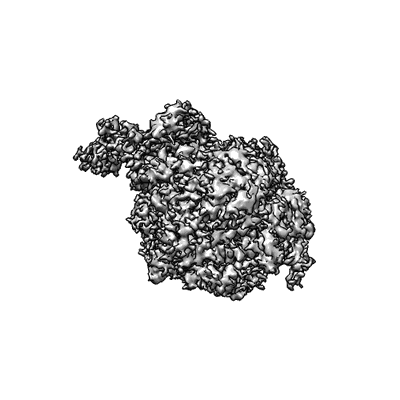EMD-9887
Structure of influenza D virus polymerase bound to cRNA promoter in class 1
EMD-9887
Single-particle3.44 Å
 Deposition: 12/04/2019
Deposition: 12/04/2019Map released: 12/06/2019
Last modified: 12/02/2020
Sample Organism:
Influenza D virus,
synthetic construct
Sample: Influenza D virus polymerase bound to cRNA promoter in mode A conformation
Fitted models: 6kuj (Avg. Q-score: 0.481)
Deposition Authors: Peng Q, Peng R, Qi J, Gao GF, Shi Y
Sample: Influenza D virus polymerase bound to cRNA promoter in mode A conformation
Fitted models: 6kuj (Avg. Q-score: 0.481)
Deposition Authors: Peng Q, Peng R, Qi J, Gao GF, Shi Y
Structural insight into RNA synthesis by influenza D polymerase.
Peng Q,
Liu Y,
Peng R  ,
Wang M,
Yang W,
Song H
,
Wang M,
Yang W,
Song H  ,
Chen Y,
Liu S,
Han M,
Zhang X
,
Chen Y,
Liu S,
Han M,
Zhang X  ,
Wang P,
Yan J
,
Wang P,
Yan J  ,
Zhang B,
Qi J,
Deng T,
Gao GF
,
Zhang B,
Qi J,
Deng T,
Gao GF  ,
Shi Y
,
Shi Y 
(2019) Nat Microbiol
 ,
Wang M,
Yang W,
Song H
,
Wang M,
Yang W,
Song H  ,
Chen Y,
Liu S,
Han M,
Zhang X
,
Chen Y,
Liu S,
Han M,
Zhang X  ,
Wang P,
Yan J
,
Wang P,
Yan J  ,
Zhang B,
Qi J,
Deng T,
Gao GF
,
Zhang B,
Qi J,
Deng T,
Gao GF  ,
Shi Y
,
Shi Y 
(2019) Nat Microbiol
Abstract:
The influenza virus polymerase uses capped RNA primers to initiate transcription, and a combination of terminal and internal de novo initiations for the two-step replication process by binding the conserved viral genomic RNA (vRNA) or complementary RNA (cRNA) promoter. Here, we determined the apo and promoter-bound influenza D polymerase structures using cryo-electron microscopy and found the polymerase has an evolutionarily conserved stable core structure with inherently flexible peripheral domains. Strikingly, two conformations (mode A and B) of the vRNA promoter were observed where the 3'-vRNA end can bind at two different sites, whereas the cRNA promoter only binds in the mode B conformation. Functional studies confirmed the critical role of the mode B conformation for vRNA synthesis via the intermediate cRNA but not for cRNA production, which is mainly regulated by the mode A conformation. Both conformations participate in the regulation of the transcription process. This work advances our understanding of the regulatory mechanisms for the synthesis of different RNA species by influenza virus polymerase and opens new opportunities for antiviral drug design.
The influenza virus polymerase uses capped RNA primers to initiate transcription, and a combination of terminal and internal de novo initiations for the two-step replication process by binding the conserved viral genomic RNA (vRNA) or complementary RNA (cRNA) promoter. Here, we determined the apo and promoter-bound influenza D polymerase structures using cryo-electron microscopy and found the polymerase has an evolutionarily conserved stable core structure with inherently flexible peripheral domains. Strikingly, two conformations (mode A and B) of the vRNA promoter were observed where the 3'-vRNA end can bind at two different sites, whereas the cRNA promoter only binds in the mode B conformation. Functional studies confirmed the critical role of the mode B conformation for vRNA synthesis via the intermediate cRNA but not for cRNA production, which is mainly regulated by the mode A conformation. Both conformations participate in the regulation of the transcription process. This work advances our understanding of the regulatory mechanisms for the synthesis of different RNA species by influenza virus polymerase and opens new opportunities for antiviral drug design.
